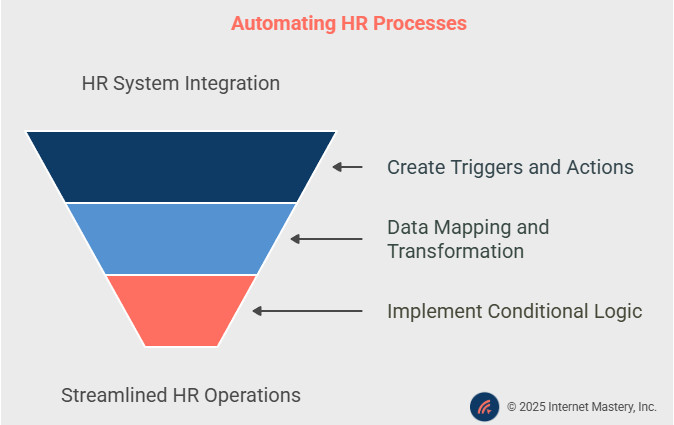Your cart is currently empty!
HR Automation: Streamlining Employee Data Management with Make.com & Zapier

Managing HR data manually is an administrative nightmare. From onboarding new employees to tracking performance and processing payroll, HR professionals often spend countless hours on repetitive tasks, increasing the risk of errors and compliance issues. What if you could streamline these processes, reduce manual effort, and improve accuracy?
Automation is the key to efficient, error-free HR data management—and tools like Make.com and Zapier make it accessible for businesses of all sizes. In this article, we’ll explore how HR automation can revolutionize employee data management and how you can leverage automation platforms to optimize your HR workflows.
Why Automate HR Data Management?
1. Reduced Errors
Manual data entry is prone to mistakes—incorrect employee details, duplicate records, and misfiled documents can lead to payroll issues and compliance risks. Automation ensures accuracy by eliminating human error and keeping records up to date in real time.
2. Time Savings
HR professionals often juggle multiple tasks, from processing leave requests to updating employee records. Automating administrative workflows allows HR teams to focus on strategic initiatives like employee engagement and talent development instead of routine data entry.
3. Improved Data Security
With sensitive employee information spread across emails, spreadsheets, and filing cabinets, data security is a challenge. Automation centralizes HR data in secure systems, ensuring better access control and compliance with data protection laws.
4. Enhanced Employee Experience
Employees expect quick responses to their HR requests. By automating routine inquiries, leave approvals, and performance tracking, companies can enhance employee satisfaction and streamline HR support.
Key Automation Scenarios in HR Data Management
1. Automated Employee Onboarding
Automating the onboarding process ensures that new hires have a seamless experience from day one. With Make.com and Zapier, HR teams can:
✅ Automatically create employee profiles in HR systems.
✅ Generate contracts, NDAs, and other essential documents.
✅ Assign training modules and notify team members of new hires.
2. Updating Employee Records
Whenever an employee updates their address, job title, or emergency contacts, automation can ensure:
✅ Instant updates across HR databases and payroll systems.
✅ Notifications sent to relevant departments for necessary adjustments.
3. Leave Management
Managing leave requests manually is time-consuming. With automation, businesses can:
✅ Allow employees to submit leave requests through an online form.
✅ Automatically route requests for approval and update records.
✅ Notify teams of approved absences in real-time.
4. Payroll Data Transfer
Payroll mistakes can be costly and frustrating. Automate data transfer between HR platforms and payroll systems like Gusto or ADP:
✅ Automatically sync payroll details with timesheets.
✅ Ensure tax deductions and benefits are calculated accurately.
✅ Reduce payroll processing time and eliminate redundant data entry.
5. Performance Tracking
Tracking employee performance can be more efficient with automation:
✅ Collect and analyze performance review data.
✅ Schedule automated reminders for performance evaluations.
✅ Provide real-time feedback tracking for managers and employees.

How to Automate HR Data Processes with Make.com & Zapier
1. Connecting HR Systems
Integrate HR platforms like BambooHR, Gusto, or Workday with other tools such as Google Sheets, Slack, and project management software.
2. Creating Triggers and Actions
Automation tools use “triggers” and “actions” to set workflows in motion. Example workflows include:
✅ “New hire added to HR system” → “Send welcome email and assign training.”
✅ “Leave request submitted” → “Send approval notification and update leave balance.”
3. Data Mapping and Transformation
Ensure seamless data flow by automatically converting, formatting, and transferring information between systems. Example:
✅ Convert salary data from spreadsheet format into a compatible structure for payroll processing.
4. Implementing Conditional Logic
Advanced workflows allow companies to handle different HR situations dynamically:
✅ “If an employee is full-time, apply standard benefits package; if part-time, apply a custom benefits package.”
✅ “If a performance score is below threshold, trigger a coaching plan.”
Best Practices for HR Data Automation
✅ Ensure Data Privacy: Implement secure data storage and encryption to protect employee information.
✅ Stay Compliant: Automate compliance tracking to meet labor law requirements.
✅ Train HR Teams: Provide proper training so teams can manage and optimize automation workflows effectively.
✅ Regular Audits: Periodically review and refine automation processes to maintain accuracy and efficiency.
Final Thoughts: Let Internet Mastery Automate Your HR Workflows
By automating HR data management, companies can reduce administrative burden, enhance accuracy, and create a seamless HR experience for employees. However, setting up automation workflows can be complex—that’s where Internet Mastery comes in!
🚀 We specialize in HR automation solutions tailored for small and mid-sized businesses.
✅ Book a Free Consultation – Let’s assess your HR processes and identify automation opportunities.
✅ We Build It for You – Our experts design and implement custom automation workflows.
✅ Enjoy Seamless HR Operations – Say goodbye to manual HR tasks and hello to efficiency!
🔗 Click here to schedule your free consultation today!
Stop wasting time on repetitive HR tasks. Let Internet Mastery streamline your HR data management so you can focus on what truly matters—your people.
Feature image by Christina @ wocintechchat.com on Unsplash
Recent Posts
- Client Onboarding Mastery: Automating a Seamless Experience with Make.com and Zapier
- Supercharge Your Sales Pipeline: Automating Lead Qualification with Make.com & Zapier
- Content Repurposing on Steroids: Automate Your Content Flow with Make.com and Zapier
- HR Automation: Streamlining Employee Data Management with Make.com & Zapier
- The Ultimate Guide to Automated Email Marketing: Skyrocket Engagement with Make.com & Zapier
